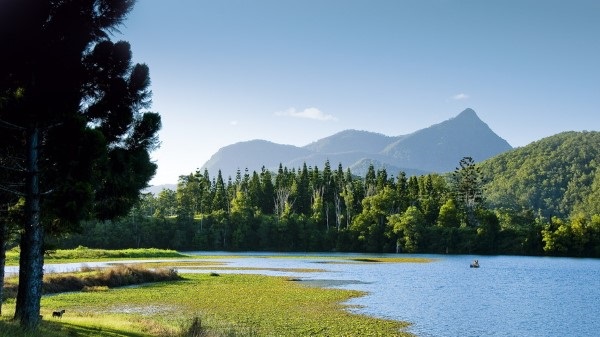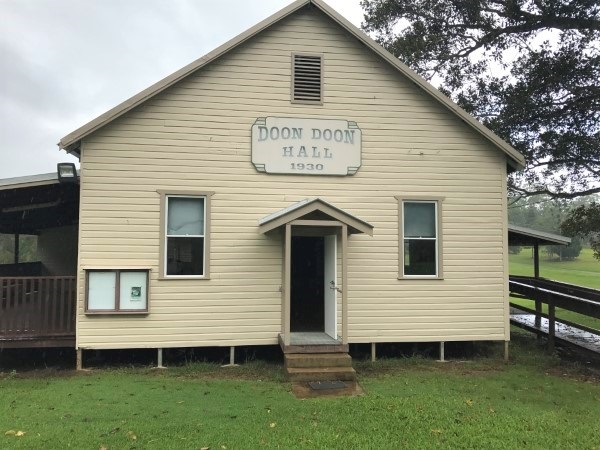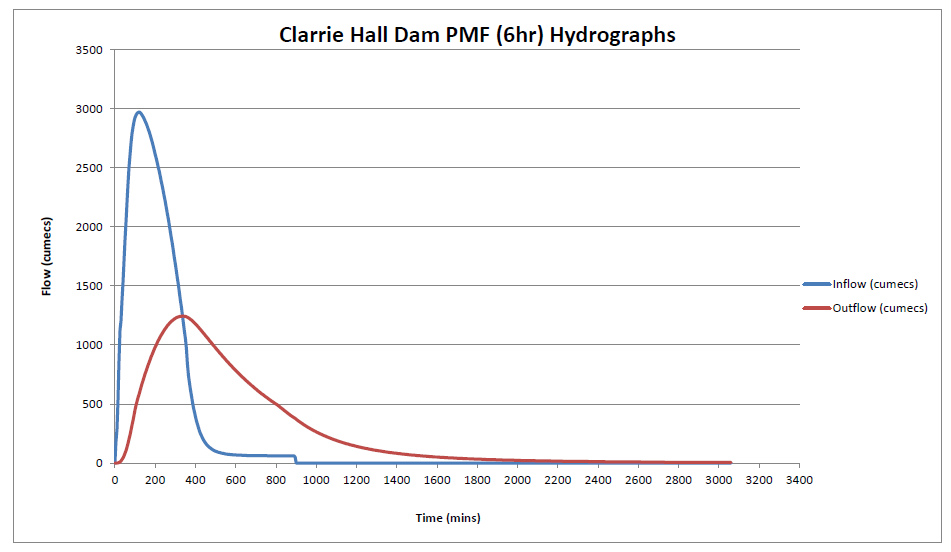Clarrie Hall Dam
Recreation areas Dam operations Water use, dam storage, rainfall Tweed Emergency Dashboard

Clarrie Hall Dam is located on Doon Doon Creek, 15 km south-west of Murwillumbah.
The Tweed’s main water supply is the Tweed River. The dam helps to keep the river flowing when water levels are low.
The dam has a catchment area of 60 km² and has a usable water supply capacity of 15,000 megalitres.
Dam levels and algae alerts
Warning signs are placed at popular water access points around the dam during algal blooms.
Check algae alerts and water levels at Clarrie Hall Dam on the water dashboard.
Recreation areas
Council maintains the recreation areas at Clarrie Hall Dam and Cram's Farm for everyone to enjoy. Please respect other visitors and wildlife. If you need to, please report a problem.
Check for site closures on our Emergency Dashboard facilities page.
Dam recreation area
45 Clarrie Hall Dam Road
Uki NSW 2484
The recreation area near the Clarrie Hall Dam wall is open to the public all year round, for day visits only.
Access to the dam wall is via security gates on Clarrie Hall Dam Road, south-west of Uki.
Gates open: 7:30 am to 5:30 pm (6:30 pm during daylight saving)
The dam is surrounded by 900 hectares of Council-owned forested land and Mount Jerusalem National Park.
The scenic location means it’s popular for photography, picnics, bush walking and bird watching. No overnight camping allowed.
Facilities at Clarrie Hall Dam include toilets, picnic areas and electric barbecues.
Further down the road (17 km) is the scenic Cram's Farm recreation area.
Cram’s Farm
Commissioners Creek Road
Commissioners Creek NSW 2484
Cram’s Farm is the main recreational area for the dam. There are 14 hectares to explore and a boat ramp for launching watercraft.
Access to Cram’s Farm is via security gates on Commissioners Creek Road, Doon Doon.
Gates open: 7:30 am to 5:30 pm (6:30 pm during daylight saving)
Crams Farm Reserve has an extensive area for recreation, toilet facilities and two large sheltered areas.

- No swimming
- No overnight camping
- No livestock grazing
- No dogs or horses
Facilities at Cram's Farm
The Dairy
The Dairy is the rustic shelter on the left when you arrive at Cram’s Farm. It can be hired during opening hours.
Booking gives you exclusive use of The Dairy, picnic tables and kitchenette (including power and water), with access to use the rest of Cram’s Farm with the general public.
Booking hire form(PDF, 195KB)
The Piggery
The second shelter known as 'The Piggery' is popular for group picnics, with electric barbecues and picnic tables.
This area is available on a ‘first in best dressed on the day’ basis and cannot be booked or cordoned off for exclusive use.
Doon Doon Hall

The hall can be hired for weddings and events. Bookings are managed by the Doon Doon Hall Trust. Hire fees apply.
Book Doon Doon Hall
Grassed area
The grassed area at Cram’s Farm can be booked for up to 3 hours for wedding ceremonies and events. A fee applies.
Recreational activities
Tracks and trails
Fire trails and tracks around the dam are available for bushwalking (day visits only).
No motorbikes or 4WDs allowed.
Boating
Petrol and diesel motors must not be used on the dam (remove from boat before entering the water).
Electric motors, sail boats, oared boats and kayaks are permitted.
A jetty and launch ramp offers access to the upper reaches of the dam. Explore by kayak and enjoy catch and release fishing.
Private properties border the dam, please do not land anywhere except the launch sites.
Read more about water recreation in the Tweed.
Fishing
Clarrie Hall Dam has been stocked with more than 300,000 Australian Bass since 1991.
NSW Fisheries regulations: 2 Bass per person, with only one fish allowed to be longer than 35 cm. Catch and release is recommended in Clarrie Hall Dam.
Dam operations
Clarrie Hall Dam’s purpose is to capture and store rainfall for drier times and then release water when needed into Doon Doon Creek, which flows into the Tweed River, the source of most of our drinking water.
When the dam fills, it is designed to safely pass the excess water into Doon Doon Creek via its open, un-gated spillway.
Clarrie Hall Dam is un-gated
Clarrie Hall Dam has been designed and built with an open and un-gated spillway. This means Council has no control over water spilling from the dam once the water level of the dam reaches the full supply level.
When rainfall in the catchment increases the water level above the dam’s full supply level, water begins to flow out of the dam, over the dam’s spillway and into Doon Doon Creek and then the Tweed River. This spilling cannot be controlled.
In the case of Clarrie Hall Dam, the full supply level is the crest level of the spillway.
Clarrie Hall Dam - How the dam works (1:59 minutes)
The dam is not built to mitigate floods
Clarrie Hall Dam’s open, un-gated spillway is not built to mitigate against flooding. Rather, it is designed to store water for drinking. There are many reasons why.
1. The dam’s location
The dam’s location on the Doon Doon Creek is great for capturing water to meet our drinking water supply needs, but it is not in a suitable location for protecting our towns and villages from flooding. This is because the dam’s catchment area takes in just 5.7% of the overall catchment area of the Tweed River and its upstream creeks and rivers.
If a flood mitigation dam was built at Clarrie Hall Dam’s location, even the closest downstream villages would continue to flood during high-rainfall events.
2. The dam’s size
To have any impact for mitigating flooding, a drastically bigger dam would be needed. However, the proposed Clarrie Hall Dam upgrade for water supply purposes is the maximum feasible size for a dam at this location.
At the moment, the dam volume is 16,000 mega litres. The proposed upgrade will increase its volume to 42,300 mega litres. Engineering modelling shows up to 117,000 mega litres of rainfall will flow into the dam’s catchment in one day during a probable maximum flood (PMF). That is 7.3 times the capacity of the current dam, or 2.8 times the capacity of the future dam, in a single day. During the February 2022 floods, we estimate 70,000 mega litres, or 4.5 times the volume of the existing dam, passed through the dam spillway in just 2 days.
3. One dam wouldn’t be enough
One dam would offer little protection. To have even a minor flood-mitigation impact throughout the Tweed Valley, we would need several very large dams to capture rainfall that feeds the Tweed, Oxley and Rous Rivers. Previous flood studies have shown large dams at those locations would not be practical.
4. The cost of building multiple dams would be extremely high
Constructing, operating and maintaining those very large dams would be extremely costly. The proposed upgrade of Clarrie Hall Dam to secure our water supply is funded by Council’s Water Supply Revenue. Flood mitigation dams would need to be funded from other sources. Council would not have a role in constructing, owning and operating flood mitigation dams as this comes under the jurisdiction of the NSW Government.
5. There would be environmental and cultural impacts
Dams have negative and positive impacts on the environment. The Environmental Impact Assessment for the proposed Clarrie Hall Dam upgrade considers the impacts of a 42,300 mega litre water-supply dam. Multiple dams for flood mitigation across the Tweed Valley would have significant environmental impacts that would need to be assessed. In the past across Australia and the world, proposed large dams have not been feasible because their impacts have outweighed their benefits. Additionally, any proposed dam upgrade or construction would need to consider cultural impacts alongside environmental impacts.
Clarrie Hall Dam does not cause flooding; in fact, it helps a little
Clarrie Hall Dam, like all open, un-gated spillway dams, helps mitigate against flooding to some extent. Dams do that by reducing the peak height of a flood. This happens even when a dam is full and water is spilling.
Excess water flowing into Clarrie Hall Dam during periods of intense rainfall flows over the dam’s open, un-gated spillway. Because the dam is wider than the river, with a large surface area and a narrow outlet (the spillway), it slows the flow of water. If the dam did not exist, these large flows would make their way very quickly to the Tweed River, resulting in higher river flow peaks downstream.

This diagram shows how Clarrie Hall Dam reduces the peak of water flowing out of the dam compared to the peak of water flowing into it.
Without the dam, the peak of outflow would be the same as the peak of inflow. With the dam, the peak of outflow is reduced – the dam slows the water down as it spreads across its wide surface. This means peak impacts downstream are reduced, however the overall duration of outflows is longer compared to no dam.
Proposed dam upgrade
The NSW Department of Planning, Housing and Infrastructure placed our Environmental Impact Statement (EIS) on raising Clarrie Hall Dam on public exhibition from 25 September to 6 November 2024.
The department will consider all submissions before making a recommendation to the Minister for Planning and Public Spaces, who will decide whether our proposal to raise the dam can go ahead and what conditions would apply.
Raising the dam by 8.5 metres would almost triple its storage capacity and secure the Tweed’s water supply until at least 2065.
The upgrade will not change the dam’s purpose – it will not be redesigned for flood mitigation.
If the project achieves Ministerial and Council approval, construction to raise the dam wall is projected to start by mid-2027, with completion in 2030.
Read about the project at Your Say Tweed.
Dam safety
Council is responsible for safety at Clarrie Hall Dam.
Dams are regulated by Dam Safety NSW, the NSW Government statutory authority under the Dam Safety Act 2015 and Dam Safety Regulation 2019. Council regularly monitors and reports on the condition of the dam under these regulations.
Clarrie Hall Dam is extremely safe structurally.
While the current spillway capacity is deemed sufficient to pass an extreme flood event, there is a very small risk of dam failure in the unlikely event of an earthquake or other catastrophic event.
Council has a Dam Safety Emergency Plan in place. The plan is activated during floods when certain dam levels are reached, or immediately if other events occur.
Annual Dam Safety Standards Report(PDF, 317KB)
See emergency management and dam safety.
